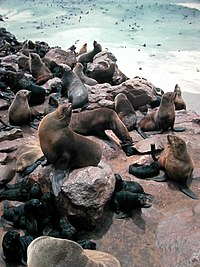
Photo from wikipedia
Recently, Coxiella burnetii has been described as a novel pathogen potentially contributing to decreased pup production in Australian fur seals (AusFS, Arctocephalus pusillus doriferus). Pacific gulls (PGs, Larus pacificus) are… Click to show full abstract
Recently, Coxiella burnetii has been described as a novel pathogen potentially contributing to decreased pup production in Australian fur seals (AusFS, Arctocephalus pusillus doriferus). Pacific gulls (PGs, Larus pacificus) are known to scavenge AusFS placental material during the fur seal breeding season. It is hypothesized that PGs may act as vectors for this pathogen. In the present study, cloacal swabs, oral swabs and serum were collected from PGs on Kanowna Island (KI, an AusFS breeding colony) and a nearby island, Seal Island (SI), not occupied by pinnipeds. All sample sets were evaluated with qPCR for the com1, htpAB and IS1111 markers. Most oral and cloacal swabs from KI tested positive on both the com1 (94.1%; 88.2%) and htpAB targets (76.5%; 76.5%). Amplification was very low from the SI oral swabs and cloacal swabs. Only the KI serum samples had amplification (17.7% for both com1 and htpAB). There was no IS1111 amplification in either colony. The results demonstrate that PGs can potentially act as vectors for the spread of C. burnetii. In some birds, C. burnetii was detectable in the serum, indicating that gulls can experience bacteraemia. It appears that different feeding strategies in the same species within the same ecosystem can have profound effects on the prevalence of pathogens. Further studies are required to better understand the epidemiology and potential risks of this organism.
Journal Title: Pathogens
Year Published: 2023
Link to full text (if available)
Share on Social Media: Sign Up to like & get
recommendations!